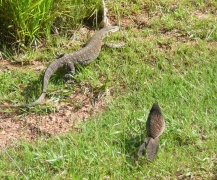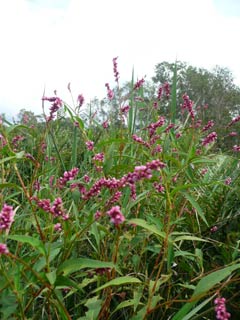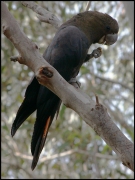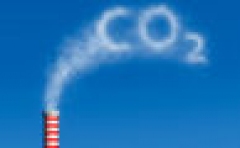
Logan and Albert Conservation Association

Environment Minister, Peter Garrett said Australian homeowners will be able to make their homes more energy and water efficient with 1000 home sustainability assessors ready to begin work and credit providers signed up to commence the rollout of the Green Loans Program from July 1.
"Through Green Loans we are making it easier for 360,000 Australian homeowners to learn what they can do to make their homes more energy efficient from an accredited assessor.
"The fact is that for many households the assessor will identify simple, low-cost actions like changing light globes, sealing draughts and repairing leaking taps.
"However, there will also be larger-scale recommendations, many of which can now be adopted at a reduced or zero cost thanks to the Government's unprecedented investment in energy efficiency - namely installing solar PV or solar hot water or ceiling insulation. Solar hot water and insulation are two of the most cost effective energy efficient changes household can make.
"And now, with the launch of Green Loans, we're also providing the opportunity for householders to access up to $10,000 for other alternate changes, enabling them to be well and truly equipped for a low pollution future."
Mr Garrett said in light of the Government's $4 billion investment in energy efficiency, lower interest rates and major shifts in the global financial markets, some changes had been made to the scheme to ensure that it is better focused:
Household assessments for 360,000 households will now come at zero cost and will no longer be tied to the loan.
Minister Garrett said home owners wishing to participate in the Green Loans Program follow three steps:
For more information on the Green Loans Program including a full list of eligibility guidelines visit www.environment.gov.au/greenloans
 Due to the overwhelming success of last years 2008 'Are you poisoning yourself?' seminar, Griffith University EcoCentre repeated the event in May 2009. The following presentations provide information about the potentially dangerous toxins we expose ourselves to everyday. These toxins are easily avoidable when you know what to look for.
Due to the overwhelming success of last years 2008 'Are you poisoning yourself?' seminar, Griffith University EcoCentre repeated the event in May 2009. The following presentations provide information about the potentially dangerous toxins we expose ourselves to everyday. These toxins are easily avoidable when you know what to look for.
The EcoCentre has published the presentations on its website and they can be accessed from this page.
Lisa Malcolm is an environmental scientist at the EcoCentre. Lisa's presentation1 will assist you to create a healthier home by making informed choices on cleaning products and safer use of plastics.
Narelle Chenery, back by popular demand, is a world wide educator and activist. She revolutionsed the beauty industry by creating the world's first certified organic skin and personal care range. Narelle's presentation2 outlines the hidden dangers of the cosmetic industry.
Dr Greg Emerson is the founder and Medical Director of the Emerson Health and Wellness Centre and co-director of Nutritional and Environmental Medicine QLD. Dr Emerson's presentation3 demonstrates the body's intrinsic ability to heal itself if the underlying cause of the illness (which can include environmental toxins) is removed.

Although the Corroboree Frog is not a species found in our local biodiversity, all plans for its recovery and survival are applauded by us.
Efforts to save one of Australia's most recognisable frogs, the Corroboree Frog, from extinction were boosted with the launch of the Corroboree Frog Conservation Trust Fund.
Minister for the Environment, Heritage and the Arts, Peter Garrett, officially launched the Trust at the Wonga Wetlands Education Centre on the Murray River near Albury.
Many Australians know Corroboree Frogs by their bright yellow and black markings. Sadly, the Corroboree Frog is seriously threatened with extinction and preservation efforts are at a critical stage.
 Barry Fitzpatrick's observations.
Barry Fitzpatrick's observations.
My animal of the month is (I think) a bird - the Pheasant Coucal. This noisy, clumsy, brash bird has whooped, clicked and hissed around our house for the past six months.
Nothing about this bird makes much survival sense. It spends a lot of its time waddling around on the ground like a lizard (a link, perhaps?), flies clumsily, and crashes into bushes or anything nearby when it wants to (or has to) land. But it must be admired for its alluring black breeding plumage, the intensity of its mating efforts, and the dedication it shows in securing food of all sorts for its young in the nest somewhere deep in grass tussocks on the adjacent Cornubia Wetland Reserve.
My admiration grew even greater as I watched it one day marching a large goanna away from its nest and off its patch. The goanna was clearly in for a feed of easily reached fresh eggs, but was completely intimidated by the strutting, clicking, bristling pheasant coucal and just did as it was told and went.
 Information supplied by Barry Fitzpatrick April 2009.
Information supplied by Barry Fitzpatrick April 2009.
My weed of the month is ragweed (Ambrosia artemisiifolia). This enterprising American import is really taking over and does not miss an opportunity. Not only does it thrive anywhere in the bush where there has been a disturbance of the natural vegetation, but it also represents a severe health risk to humans, being regarded as the world's worst hay fever and asthma allergen plant. This has not been a good trade arrangement. After all, we gave the Americans our eucalypts and tea trees, and these are used to make stuff to sooth cold and flu symptoms and are probably good for asthma too.
I have seen (and hand pulled) from Cornubia Wetland Reserve, forests of ragweed two metres high and so densely packed that there was nothing else. It is interesting that this particular crop was located on a patch that the council had heavily sprayed in previous years, without any follow up work.
 Information supplied by Barry Fitzpatrick April 2009.
Information supplied by Barry Fitzpatrick April 2009.
My plant of the month for April is Persicaria elatior, a wetland smartweed with deep pink flowers. This plant has recently been discovered growing in the Cornubia Wetland Reserve, which is sandwiched between the M1, Beenleigh - Redland Bay Road, and light industrial and urban areas.
Listed as vulnerable under the Queensland Nature Conservation Act, Persicaria elatior has rarely been seen in Queensland, being recorded by the Queensland Herbarium only 6 times before this discovery.
But it is making a comeback. In summer last year, there were only three specimens found growing at the southern end of the reserve, and another eight at the northern end. This year there are around 30 plants in the southern section alone, and with new management plans being put in place for this recently acquired reserve, Persicaria elatior's future here looks secure.
 Mt Barney Lodge Birdweek commences on National Threatened Species Day. This is particularly relevant to the local Glossy Black Cockatoo.which frequents the area of Mt Barney. This bird has a very restricted diet - only eating from two types of casuarinas in South East Queensland.
Mt Barney Lodge Birdweek commences on National Threatened Species Day. This is particularly relevant to the local Glossy Black Cockatoo.which frequents the area of Mt Barney. This bird has a very restricted diet - only eating from two types of casuarinas in South East Queensland.
National Threatened Species day is held annually on 7 September. The federal government site provides factsheets on many endangered species. Find it here http://www.environment.gov.au/biodiversity/threatened/ts-day/index.html.
On 9-13th September there will be lots of activities to take part in at Mt Barney - a variety of professionally guided birdwalks, birding workshops, and an evening firedance spectacular.
Barry Davies one of Scenic Rim's internationally renown authority on birds will be guiding field trips. See LACA events page for more information about this week and this page for more information about our unique and vulnerable Glossy Black Cockatoo.
 koalas_submission_seqrp.doc 213.00 Kb 23/04/2009, 07:35 Copy of BREC submission to SEQRP.
koalas_submission_seqrp.doc 213.00 Kb 23/04/2009, 07:35 Copy of BREC submission to SEQRP.  Logan Escarpment is home not only to koalas but also to a range of native species such as the powerful owl, squirrel and greater gliders, swamp wallaby and the endangered Sword-grass brown butterfly.
Logan Escarpment is home not only to koalas but also to a range of native species such as the powerful owl, squirrel and greater gliders, swamp wallaby and the endangered Sword-grass brown butterfly.
By expanding the network of reserves in this area, Logan Escarpment will enhance the connectivity between the Venman Bushland National Park, Daisy Hill Conservation Park and Neville Lawrie Reserve. This whole of landscape conservation network is essential to help our plants and animals deal with the pressures they face especially habitat loss and climate change.
 How are we and the wildlife to adapt to the impacts of climate change and global warming.?
How are we and the wildlife to adapt to the impacts of climate change and global warming.?
The following news story which was published in a recent Indonesian paper as Plagued Southern Land and also the Los Angeles Times paints a challenging scenario. Many have lost their lives.
Frank Eddy, his hands as dry and cracked as the orchards he tends, explained what damage a decade of drought has done.
"Suicide is high. Depression is huge. Families are breaking up. It's devastation," he said. "I've got a neighbor in terrible trouble. Found him in the paddock, sitting in his [truck], crying his eyes out. Grown men - big, strong grown men. We're holding on by the skin of our teeth. It's desperate times."
They call Australia the "Lucky Country" with good reason. Generations of hardy castoffs tamed the world's driest inhabited continent, created a robust economy and cultivated an image of resilient people who can't be held down.
Australia exports itself as a place of captivating landscapes, brilliant sunshine, glittering beaches and an enviable lifestyle.
Look again. Climate scientists say Australia - beset by prolonged drought and deadly bush fires in the south, monsoon flooding and mosquito-borne fevers in the north, widespread wildlife decline, economic collapse in agriculture and killer heat waves - epitomizes the "accelerated climate crisis" that global warming models have forecast.
With few skeptics among them, Australians appear to be awakening: Adapt to a rapidly shifting climate and soon.
Australian scientists warn that the experience of the island continent is an early cautionary tale for the rest of the world.
"Australia is the harbinger of change," said paleontologist Tim Flannery, Australia's most vocal climate-change prophet. "The problems for us are going to be greater. The cost to Australia from climate change is going to be greater than for any developed country. We are already starting to see it."
Many believe Australia has a death toll connected to climate change: the 173 people who died in February 2009 during the nation's worst-ever wildfires and the 200 who died from heat the week before.
A three-person royal commission has convened to decide, among other things, whether global warming contributed to massive bush fires that destroyed entire towns and killed a quarter of Victoria state's koalas, kangaroos, birds and other wildlife. The commission's proceedings mark the first time anywhere that climate change could be put on trial. And it will take place in a nation that still gets 80 percent of its energy from burning coal, the globe's largest single source of greenhouse gases. The commission's findings aren't due until August, but veteran firefighters, scientists and residents believe the case has already been made.
Even before the flames, 200 Melbourne residents died in a heat wave that buckled the steel skeleton of a new 120-meter Ferris wheel and warped train tracks like spaghetti. Cities experienced four days of temperatures at 40 degrees Celsius or higher with little humidity and 16-kph winds. In areas where fires hit, temperatures reached almost 50 degrees. On the hottest day, more than 4,000 gray-headed flying foxes dropped dead out of trees in one Melbourne park.
"Something is happening in Australia," Dan Condon, a firefighter of the Melbourne Metropolitan Fire Brigade, wrote in an open letter. "Global warming is no longer some future event that we don't have to worry about for decades. What we have seen in the past two weeks moves Australia's exposure to global warming to emergency status."
The possibility that a high-profile royal commission may find a nexus between climate change and the loss of human life is significant for many scientists in Australia.
"That will be an important moment in its own right," said Chris Cocklin, a climate change researcher at James Cook University in Townsville, in Queensland state, and lead author on the latest report from the Intergovernmental Panel on Climate Change. "It may mean that climate change will be brought to the fore in a way that has never happened."
Australia's climate-change predicament is on depressing display in the Murray-Darling Basin, where the country's three largest rivers converge. The Murray, Darling and Murrumbidgee rivers flow from the western slopes of the Great Dividing Range and nourish the valleys of Australia's fruit and grain basket, as well as a diverse system of wetlands, grasslands and eucalyptus forests.
Farmers who once grew 60 percent of the nation's produce are walking off their land or selling their water rights to the state and federal government. With rainfall in the region at lower than 50 percent the average for more than a decade, Australia is witnessing the collapse of its agricultural sector and the nation's ability to feed itself.
In rural Victoria, one rancher or farmer a week takes his own life. Public health officials say hanging is the preferred method.
"Fourteen dairy farmers in the valley have committed suicide in the last five years," Eddy said. "Hangings, they are common but they are not made public. It's really depressing, it's really tough going.
"Fruit growers are abandoning their orchards. It's their life's work, and it's gone to dust. They are at their wits' end. The small growers haven't got the money to replant, haven't got the time to wait five years for a return.
"The machinery they have is not saleable. They have thrown their arms up and walked away. They are broken people."
Santo Varapodio, 73, is the patriarch of a family that runs one of the largest fruit operations around the nearby agricultural center of Shepparton. The area's annual rainfall used to be 48 to 53 centimeters a year.
"Now we're lucky if we get [15 to 18 centimeters]," Varapodio said.
This summer's heat wave "cooked" his fruit. "When we bring the pears in, about 15 percent will have burn on them."
"The apples will have anything up to 50 percent sunburn on them," he said.
Rainfall patterns have been frustratingly uncooperative. Gentle winter showers that replenished groundwater have been replaced by torrential summer onslaughts that turn the fertile topsoil into a slough.
Much of the country is in the grip of the worst drought in more than a century. Every capital in Australia's eight states and territories is operating under considerable water restrictions. In urban areas, "bucketing" has become a common practice - placing pails in showers and using the "gray water" on lawns or gardens. In some cities, such as Brisbane, residents drink recycled water, a process nicknamed "toilet to tap." In rural areas, the lucky tap their own wells, if they still function. Others survive on rainwater or what they can scrounge or buy.
Meanwhile, the tropical north's rainy season, known as the Big Wet, is longer and wetter than ever. Warming tropical waters in the Coral Sea and the Gulf of Carpentaria spawn increasingly powerful cyclones, while rainfall and heat records are broken every year.
The coastal city of Darwin, in the Northern Territory, swelters through 20 to 30 days of temperatures above 35 degrees, with high tropical humidity. Government scientists project that by 2070, Darwin will experience such conditions as many as 300 days a year. Communities on the Cape York Peninsula accustomed to being flooded for days are now cut off for weeks.
Throughout February, the Queensland government air-dropped supplies to citizens, who had to wait to re-emerge when the water receded in the Southern Hemisphere's autumn, in late March or early April. In the meantime, in-ground burials are on hold.
The region is beset with twin epidemics of malaria and a dangerous form of hemorrhagic dengue fever from mosquitoes that breed in standing water. Such diseases are expected to become more common in the tropics as the climate changes.
The north's two largest tourism draws, the Great Barrier Reef and the Tropical Rainforest Reserve, are withering under climate extremes. Higher ocean temperatures are bleaching coral and affecting fish and plant species.
A 2008 report by the Intergovernmental Panel on Climate Change projected that the Great Barrier Reef would be "functionally extinct" by 2050.
Inland, tropical forests are retreating up mountainsides as species of towering trees die off at lower altitudes and re-establish themselves in cooler climes. Rare and unique animals are on the move, competing for scant space atop Australia's modest topography. In many areas, the vertical distance from the tree line to a mountain's peak is less than 400 meters.
"If you are at the top of the mountain, it will only take a couple of degrees to push you off the top," said Stephen Williams, director of the Center for Tropical Biodiversity and Climate Change in Townsville.
Scientists paint a bleak picture of wildlife competing for space on peaks in the country's alpine region. Williams and other biologists predict as much as 50 percent animal extinction in the region by the end of the century.
Chief among the candidates for extinction is the rare white lemuroid ringtail possum, a singular species that Flannery describes as "our panda." The pale creatures live high in trees in the 10,400 square kilometers of moist forest in northeast Queensland. They can't tolerate, even for hours, temperatures above 30 degrees Celsius. Williams' research found that the possum was gone from one of the animal's two historical ranges, and in the other it "has declined dramatically, to the point where you can barely detect it." Scientists are frustrated that such dramatic evidence hasn't sparked action from Australia's government.
They suspect the inaction can be partly explained by examining the nation's relationship with coal. Australia is the world's largest exporter of coal and relies on it for 80 percent of its electricity. That helps make Australia and its 21 million people the world's highest per-capita producers of greenhouse gases in the industrialized world. Cocklin said the massive receipts coal companies bring in render the industry politically untouchable.
Prime Minister Kevin Rudd says climate change is high on his agenda, but many people are disappointed by his pledge to cut overall greenhouse gas emissions by only 5 percent by 2020.
Scientists and policy makers now agree that even drastic cuts won't halt climate changes already under way. In response, some Australians are considering whether outback settlements should be abandoned.
"We are already very flat and very dry as a continent," Flannery said. "There is just this little margin that is inhabitable. We don't have a lot of options."
Many Australians live on the coast, where they are vulnerable to flooding because of rising sea levels, projected to increase by almost 2 meters this century.
"Some places are pretty close to being bloody unlivable anymore," Cocklin said. "When you start talking about places where 45 degrees is commonplace, that raises the question ... ‘Can you really live in that?'"